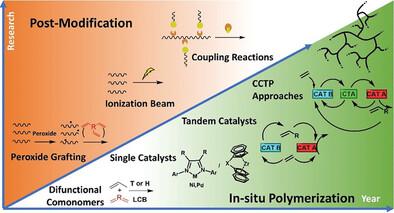当前位置:
X-MOL 学术
›
Macromol. Rapid Commun.
›
论文详情
Our official English website, www.x-mol.net, welcomes your feedback! (Note: you will need to create a separate account there.)
Recent Advances in Controlled Production of Long-Chain Branched Polyolefins
Macromolecular Rapid Communications ( IF 4.6 ) Pub Date : 2024-03-15 , DOI: 10.1002/marc.202300746 Arezoo Dashti 1 , Mostafa Ahmadi 1, 2
Macromolecular Rapid Communications ( IF 4.6 ) Pub Date : 2024-03-15 , DOI: 10.1002/marc.202300746 Arezoo Dashti 1 , Mostafa Ahmadi 1, 2
Affiliation

|
Polyolefins, composed of carbon and hydrogen atoms, dominate global polymer production. This stems from the wide range of physical and mechanical properties that various polyolefins can cover. Their versatile properties are largely tuned by chain microstructure, including molar mass distribution, comonomer content, and long-chain branching (LCB). Specifically, LCB imparts unique characteristics, notably enhances processability crucial for downstream applications. Tailoring LCB structural features has encouraged academic and industrial efforts, chronicle in this review from a chemistry standpoint. While encompassing post-reaction modification based traditional methods like peroxide grafting, ionizing beam irradiation, and coupling reactions, the main focus is given to catalyst-centric strategies and innovative polymerization schemes. The advent of single-site catalysts—metallocenes and late transition metals catalysts—amplifies interest in tailored chemical methods, but the progress in LCB formation flourishes via tandem catalytic systems and bimetallic catalysts under controlled reaction conditions. Specifically, the breakthrough in coordinative chain transfer polymerization unveils a novel avenue for controlled LCB synthesis by sequential chain propagation, transfer, liberation, and enchainment. This short review highlights recent approaches for the production of LCB polyolefins that can provide a roadmap crucial for researchers in academia and industry, steering their efforts toward further advancements in the production of tailored polyolefin.
中文翻译:

长链支化聚烯烃控制生产的最新进展
由碳和氢原子组成的聚烯烃在全球聚合物生产中占主导地位。这源于各种聚烯烃可以涵盖的广泛的物理和机械性能。它们的多功能特性很大程度上取决于链微观结构,包括摩尔质量分布、共聚单体含量和长链支化 (LCB)。具体来说,LCB 具有独特的特性,特别是增强了对下游应用至关重要的加工性能。从化学的角度来看,定制 LCB 结构特征鼓励了学术界和工业界的努力。虽然涵盖基于反应后改性的传统方法,如过氧化物接枝、电离束照射和偶联反应,但主要关注以催化剂为中心的策略和创新的聚合方案。单中心催化剂(茂金属和后过渡金属催化剂)的出现增强了人们对定制化学方法的兴趣,但通过串联催化系统和受控反应条件下的双金属催化剂,LCB 形成的进展蓬勃发展。具体来说,配位链转移聚合的突破揭示了通过顺序链增长、转移、释放和链锁控制LCB合成的新途径。这篇简短的综述重点介绍了 LCB 聚烯烃的最新生产方法,这些方法可以为学术界和工业界的研究人员提供至关重要的路线图,引导他们努力进一步推进定制聚烯烃的生产。
更新日期:2024-03-15
中文翻译:

长链支化聚烯烃控制生产的最新进展
由碳和氢原子组成的聚烯烃在全球聚合物生产中占主导地位。这源于各种聚烯烃可以涵盖的广泛的物理和机械性能。它们的多功能特性很大程度上取决于链微观结构,包括摩尔质量分布、共聚单体含量和长链支化 (LCB)。具体来说,LCB 具有独特的特性,特别是增强了对下游应用至关重要的加工性能。从化学的角度来看,定制 LCB 结构特征鼓励了学术界和工业界的努力。虽然涵盖基于反应后改性的传统方法,如过氧化物接枝、电离束照射和偶联反应,但主要关注以催化剂为中心的策略和创新的聚合方案。单中心催化剂(茂金属和后过渡金属催化剂)的出现增强了人们对定制化学方法的兴趣,但通过串联催化系统和受控反应条件下的双金属催化剂,LCB 形成的进展蓬勃发展。具体来说,配位链转移聚合的突破揭示了通过顺序链增长、转移、释放和链锁控制LCB合成的新途径。这篇简短的综述重点介绍了 LCB 聚烯烃的最新生产方法,这些方法可以为学术界和工业界的研究人员提供至关重要的路线图,引导他们努力进一步推进定制聚烯烃的生产。



























 京公网安备 11010802027423号
京公网安备 11010802027423号